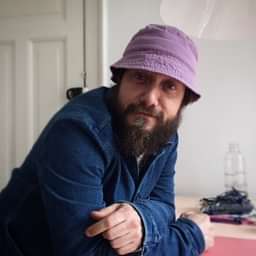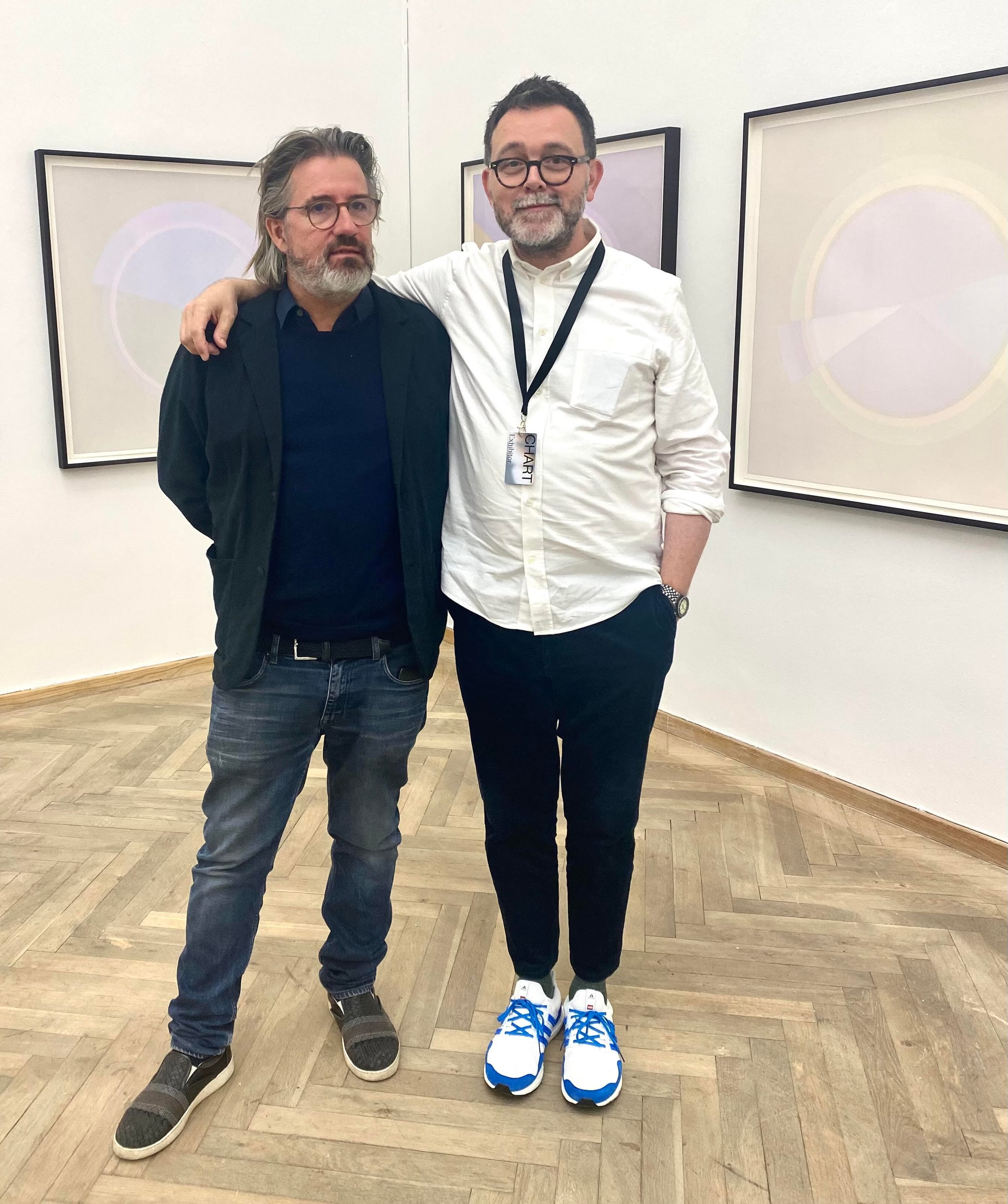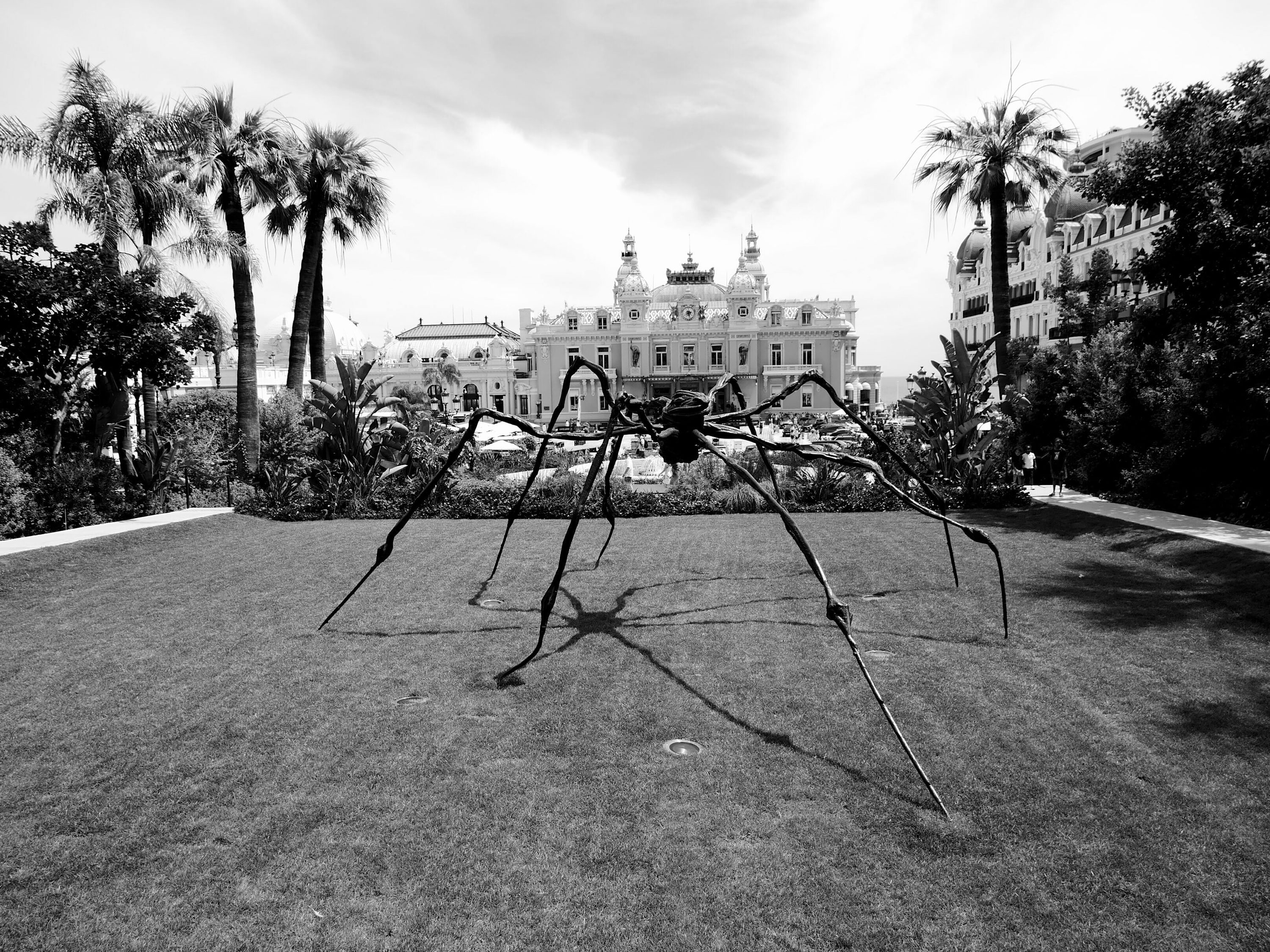
Jesper Elg in the V1 Gallery office
Photo by Nikolaj Thaning Rentzmann
All superheroes have a creation myth, what's yours? What got you started? Not many kids say: “I want to be a gallerist when I grow up.” How did you get into it?
It felt like a calling. A cultural calling that needed to be answered. We had been privileged and seen and engaged with artists and art around the Western world that didn’t yet have a platform. It felt important to build this platform together with the artists, the community, and the audience. No gallery is an island.

Jesper Elg and Cali Thornhill DeWitt in Eighteen after installing the artist's solo exhibition 29 Flags in 2016.
"The artist and gallerist relationship is ultimately about trust. You have to trust in each other and honour that trust. You go through many ups and downs together, so you have to share the same vision and strategy, for the long run - for where you should go and when."

Mikkel and Max installing for Chart 2021
"Art handling is one of the many tasks that comes with the job. Both Mikkel and I enjoy being physically involved in the process - this is where you make the final choices, that could not be foreseen when you were doing the layout in InDesign. Once the work is in the space, things always change."
You walk into the packed dining room of the restaurant at Kunsthalle Basel the night of the opening of ART Basel. There are two large tables: one full of artists, one full of collectors. You can choose one table for the evening. Where do you sit and why?
We like to book our own tables and would never book at Kunsthalle (overrated and overpriced), but our table at Bodega zum Strauss would be a good mix of artists, collectors and arts professionals.
Or rather the question leads to a classical art world cliché: that artists are fun, genuine and good company, and art collectors are not, which, considering personal empirical field research over the past two decades (hard work and hard data), is a faulty assumption. I have certainly met collectors that are horrible humans, that I would rather not share a table with, but the same goes for artists.
Unfortunately, as a gallerist you often find yourself in a situation where you have no say in the seating plan (I won’t name any museums or art fairs) and you must navigate these situations as a kind of UN representative. As we know from the surrounding world, the outcome is not always as intended, borders are crossed, shots are fired. But more often, you experience that people from very different backgrounds and purposes meet, engage and exchange over art in these settings.
Sometimes it seems almost miraculous, and it restores a bit of faith in the potential of art and the people engaged in it.

Dan Colen, Thomas Øvlisen, Jesper Elg, Peter Funch, Nina Beier and Marie Lund
"Contrary to my answer, this photo from Kunsthalle in Basel in 2007 seems to indicate, that I do prefer to hang out with artists."

Wes Lang dinner in Eighteen
"Gallery dinners can be fun - bringing together an eclectic mix of people who are all engaged in art and celebrating years of work."
What is your role? (talk about what you think the most important parts of your job are, what is your function, what is your role in the artworld?) (curator / agent / manager / salesperson / therapist / bank / coach / host / entertainer / accountant / magician… )
All of the above plus janitor, shipping-logistics officer and art handler. One could also summarize the position as art facilitator. Our most important role is to facilitate the works of artists, so as to allow them to create interesting works of art; you try to do that in every way possible. I believe that is the raison d’etre of a gallerist.

All hands on deck for Barry McGee installation in Eighteen in 2018.
"Installing exhibitions together with artists and collaborators is one of the most amazing things about being a gallerist. Years of work align in some intense days."

Installation view, Barry McGee solo exhibition Tar Pit in Eighteen, 2021
Photo by Jan Søndergaard
What are your responsibilities and to who?
Oh no, this is going to sound like an Academy Awards speech for Best Janitor. As a gallery you have a responsibility to help bring something interesting into the world, something that wasn’t there before, something that could have potential.
You have a responsibility to the art, to the artists who create the art, to the public who engage with the art, to the institutions and people who purchase the art, to the people who help produce the art and the exhibitions and ultimately to all the people that place their trust in you.
We try to be aware of all these responsibilities, while not letting them become inhibiting to the core pursuit of facilitating interesting art. It is not a balance, it is a series of choices.

Installation View, Robert Nava solo exhibition, Mythologies, in V1 Gallery, 2019.
Photo by Jan Søndergaard

Sara-Vide Ericson facing herself in her solo exhibition Obsolete Decoy in Eighteen, 2019
Photo by Jan Søndergaard
What was the first show you made?
It was an exhibition with the New York-based Japanese, American and Canadian art collective Faile, in November 2002. We had invited them to do an exhibition and they in-turn invited the Swedish artist Akay to co-exhibit with them.
We had just spent two months around the clock renovating the gallery space, a former bakery-turned-bondage club-turned-Turkish tea club-turned-bicycle storage, trying to bring the old bakery back to life and make neon green walls appear white and somewhat levelled.
Faile and Akay arrived and created one large, vivid and immersive installation, wheatpasted and painted directly on to the walls, floor and ceiling of the gallery. They destroyed the newborn gallery in the best sense of the expression.
It looked overwhelming and radical. There were only a few screen prints and some very limited handmade t-shirts to sell at prices ranging between €33 and €666. Needless to say, it took us a little time to figure out a sustainable business model.

Faile & Akay. V1 Gallery opening night, November 2002
Photo by Asger Carlsen

Jesper Elg and Peter Funch (co-founder of V1, artist) at the opening of V1 in 2002.
Photo by Asger Carlsen (artist)
The American comedian Chris Rock said, Michael Jackson is rich, the guy who signs his cheques is wealthy. Anthony D'Offay said, you can get rich selling art but you get wealthy buying art. Do you collect art? From the artists you represent? More widely?
In Scarface, Elvira Hancock’s advice to Tony Montana is: “Don’t get high on your own supply” and we all know how that ends.
As soon as I could afford to buy art, I did. I have always collected the artists we work with and also other artists I admire. I think it is such a privilege to live with art. I don’t get a kick out of the ownership part, it’s the opportunity to be around the work that is important. In the long run I don’t really believe you can own a work of art, it has its own autonomy and trajectory, you can take care it for a while, and you should.
That means you should not store it crated in a freeport until you resell it with the next auction house. Coming back to Elvira’s wise words to Tony: We have always had a rule in the gallery, that we could only purchase works from the exhibition once it was over, so we wouldn’t interfere with clients and institutions wishing to acquire works.
In that sense we are dealers and communicators before collectors. On a personal level, this rule often costs us substantial emotional and financial disappointment. So many works you love found new homes. Many of these works also made some people a substantial amount of money. That is part of the profession. Part of your responsibility as a gallerist is to prioritise sending the work out into the world instead of keeping it for yourself. While our track record certainly shows that a work of art can make you money, if that is your desire, I don’t know a gallerist that started their gallery in order to become wealthy. I’m sure you can find some, I just don’t know any that were motivated by that dream.

Wes Lang and Jesper Elg in LA.
"Some works of art end up in the permanent collection." Photo by Mikkel Grønnebæk

Jesper Elg, Mikkel Grønnebæk and Peter Funch at Art Basel, circa 2008.
"Normally our relation is very civil and professional, but of course curatorial tensions can rise." Photo by Peter Funch
How has your role changed since you started? (for good and for bad)
Fundamentally the gallery has not changed. We are still motivated by the same ambitions of facilitating interesting ideas, exhibitions and artists. We now have a bigger responsibility to a larger group of artists, clients and collaborators.
My personal role in the galleries - we currently have three exhibition spaces - has naturally shifted over the past 20 years. While still performing many of the aforementioned roles and tasks, I now have more time to focus on my work with the artists. Surrounded by a strong team of artists and competent colleagues, gallery life feels less like solo climbing and more like a team effort: a band of sisters and brothers that share a vision and a confidence in one another.
The world is constantly changing, obviously, but the art world used to be first movers, be the avant-garde, and I don’t think that is true in general at the moment. I think it is a little behind in dealing with many contemporary issues of sustainability, both environmental and human.
Are the inner workings of the artworld today really built on traditional global art fairs and auction houses - arenas of pure commerce? I think there is a change happening regarding commerce, due diligence, environmental behavior, social responsibility- and representation, and sustainability in general in the art world. The time is certainly now.

Installation View, Danny Fox solo exhibition, Doped, Roped and Horoscoped, in Eighteen, 2019.
Photo by Jan Søndergaard.

Installation View, George Rouy solo exhibition, Cut Down A Tree To Build A Wooden Horse, To Ride You May Get Splinters, in V1 Gallery, 2019.
Photo by Jan Søndergaard

David Risley is an artist. He ran David Risley Gallery, in London (2002-2010) and Copenhagen (2010-2018). He was founding Co-curator of Bloomberg Space, London (2002-2005), Co-founder of Zoo Art Fair, London (2004), and Co-founder and Co-owner of CHART. He continues to write, curate, and develop projects with artists. He is developing a sustainability project for public-facing institutions.

Jesper Elg is the co-founder, director, and owner of V1 Gallery, which represents a select group of emerging and established artists and is committed to introducing art, in all media, to an international audience. Seeing art as a profound and competent media for social and political discourse, the gallery aspires to serve as a platform for art that interacts with the surrounding society. Today the gallery has two locations in the central meatpacking district of Copenhagen.


